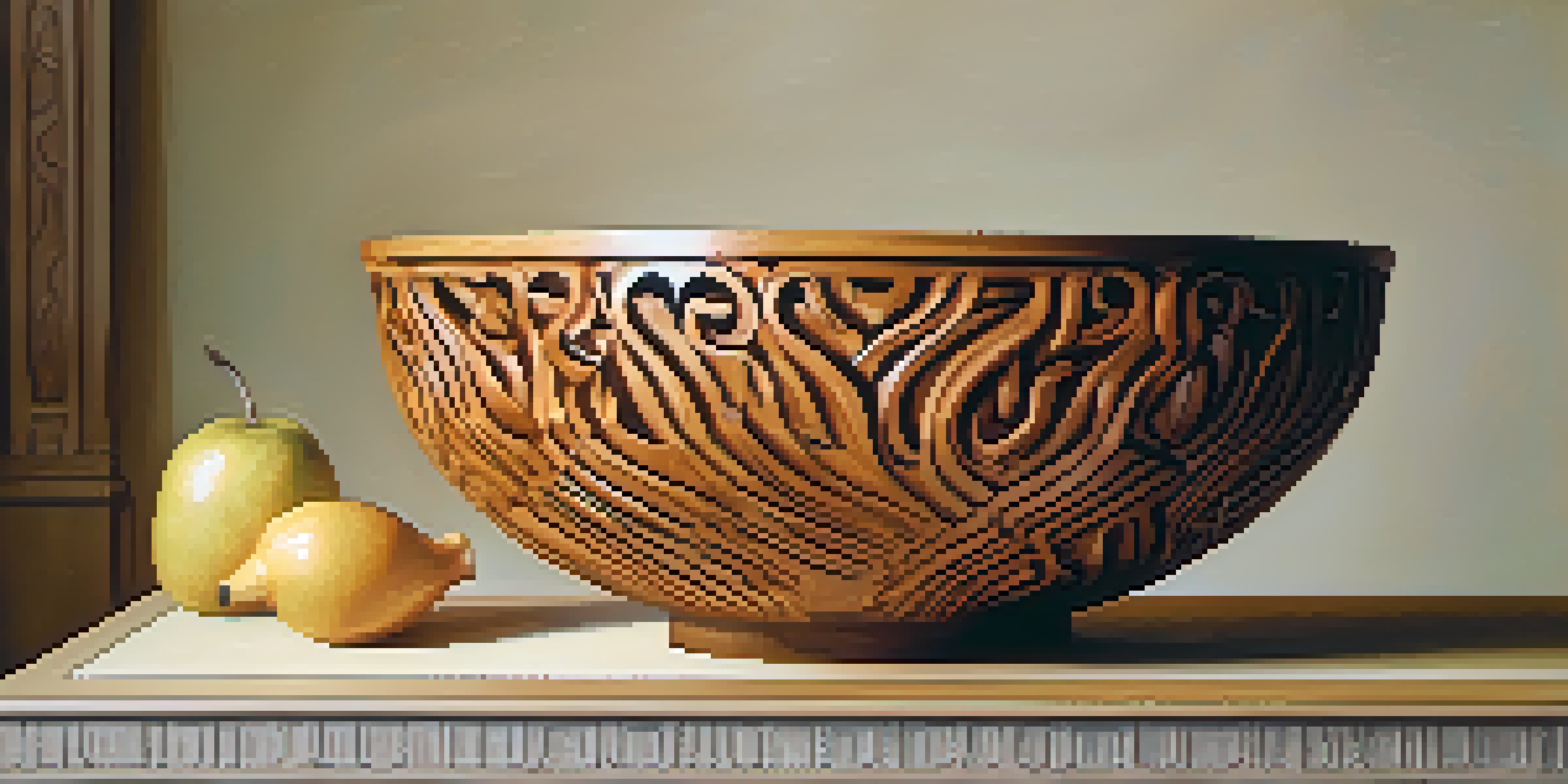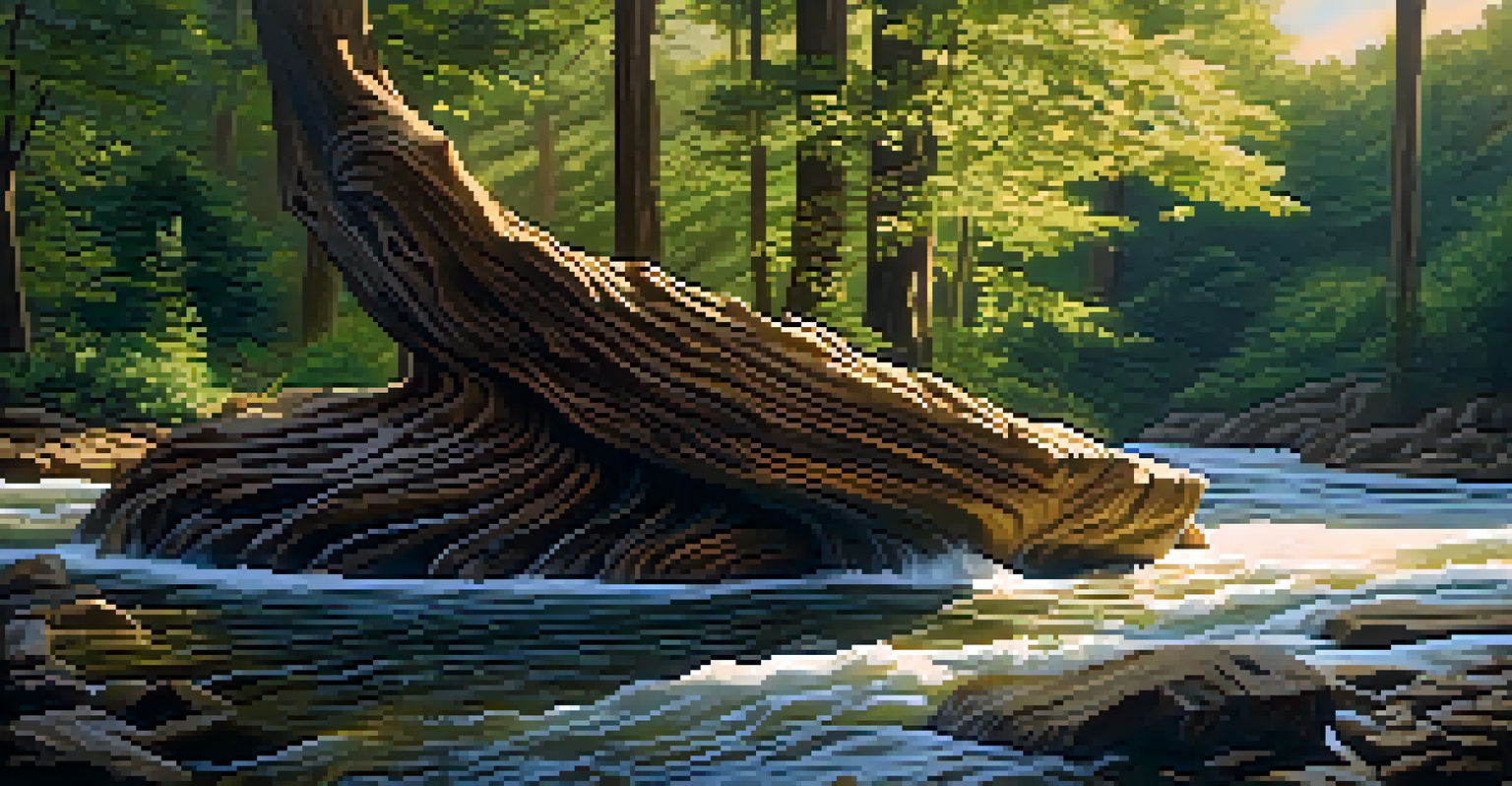Creating Flow in Carving: Techniques for Seamless Designs

Understanding the Concept of Flow in Carving
Flow in carving refers to the seamless integration of shapes and patterns that create a harmonious visual experience. Think of it like a river that meanders gracefully through a landscape, connecting various elements along its path. When applied to carving, flow ensures that each curve and line complements the others, resulting in a cohesive design.
The beauty of a curve is not in its shape, but in the flow it creates.
To achieve flow, it's essential to visualize the overall pattern before you begin your work. Sketching out your ideas can help you see how different elements will interact with one another. This preliminary step allows you to identify areas where the design might feel disjointed, giving you a chance to make adjustments and enhance the overall fluidity.
Ultimately, understanding flow is about more than aesthetics; it also plays a crucial role in the functionality of the carved piece. A well-flowing design can enhance the performance of the item, whether it's a decorative object or a functional tool, leading to a satisfying experience for both the creator and the user.
Choosing the Right Materials for Flow
The materials you select for your carving project can significantly impact the flow of your design. Softwoods like pine or basswood are often preferred for their ease of carving, allowing for smooth transitions and intricate details. On the other hand, harder woods can offer durability but may require more effort to achieve that seamless look.

Consider the grain of the wood as well; a straight grain can enhance a flowing design by providing a consistent backdrop for your patterns. Conversely, a highly figured wood with swirling grains can create interesting visual effects but may complicate the flow if not managed properly. Testing different materials can provide insights into how they influence your carving techniques.
Flow Enhances Carving Aesthetics
Achieving flow in carving involves creating harmonious shapes and patterns that enhance visual appeal.
In addition to wood, other materials such as stone, clay, or synthetic composites can also be used. Each material comes with its own set of challenges and advantages, so experimenting with various options can help you discover what works best for your specific design intentions.
Essential Tools for Carving with Flow
Having the right tools is crucial for achieving flow in your carving projects. Basic carving tools like gouges, chisels, and knives allow for precise cuts and smooth curves. Specialized tools, such as rotary tools or power carvers, can also help you create intricate designs with greater ease and speed.
Art is the most beautiful of all lies; it is the flow of imagination into form.
It's important to understand how each tool can affect the flow of your work. For instance, a curved gouge can help you carve rounded shapes that contribute to a flowing design, while a straight chisel may be better suited for defined edges. Familiarizing yourself with the capabilities of your tools can lead to more intentional carving decisions.
Don't forget about tool maintenance as well; sharp tools not only make your work easier but also contribute to cleaner lines and smoother transitions. Regularly honing and sharpening your tools can help ensure that you achieve the best possible flow in your designs.
Techniques for Creating Seamless Curves
Creating seamless curves is a fundamental aspect of achieving flow in carving. One effective technique is to use the 'stop cut' method, where you make a shallow cut to define the edge of your curve before carving deeper. This technique helps create clean lines and prevents any unwanted slips that could disrupt the flow of your design.
Another technique is to visualize the curve in your mind and practice it with your hand before making the cut. This mental practice can help you develop a feel for the movement and control needed to create smooth, flowing lines. Additionally, utilizing a flexible template can guide your hand and ensure consistency across the curves.
Materials Impact Design Flow
The choice of materials, like softwoods or harder woods, significantly influences the flow and intricacy of your carving.
Finally, patience is key when carving curves. Rushing through the process can lead to jagged edges or uneven surfaces, which can compromise the overall flow of your piece. Take your time to refine each curve, and don't hesitate to step back and assess your work from different angles to ensure seamless integration.
Incorporating Patterns for Enhanced Flow
Patterns can significantly enhance the flow of your carving designs by adding visual interest and depth. Consider incorporating repetitive motifs that echo the natural flow of your overall piece. For example, a series of leaf patterns can guide the eye along the curves of a carved surface, creating a sense of movement.
When selecting patterns, think about how they interact with the existing shapes in your design. Patterns should complement, not compete with, the fundamental flow of your carving. Experimenting with various scales and placements can help you discover the perfect balance that enhances the overall design.
Additionally, using contrasting textures can create a dynamic interplay between smooth and rough surfaces, further contributing to the perception of flow. By strategically placing these textures, you can guide the viewer’s eye and enhance the tactile experience of your carved piece.
Practicing Patience and Precision in Carving
Patience and precision are essential virtues in the art of carving, especially when striving for seamless designs. Rushing through the process can lead to mistakes that disrupt the flow you’re aiming for. Take the time to focus on each cut, ensuring it aligns with your vision for the piece.
A great way to cultivate these qualities is through regular practice. Set aside time to carve smaller pieces where you can refine your technique without the pressure of a larger project. This practice allows you to experiment with flow and understand how different approaches affect the final design.
Patience is Key for Precision
Practicing patience and precision in your carving process is essential for achieving smooth, seamless designs.
Remember, carving is as much about the journey as it is about the finished product. Embracing a mindful approach will not only improve your skills but will also enhance the joy and satisfaction you derive from creating flowing designs.
Final Touches to Enhance Flow in Your Carvings
The final touches on your carving can make a significant difference in enhancing its flow. Sanding is a crucial step; it helps smooth out any rough edges and creates a polished surface that complements the flowing design. Taking the time to sand your piece properly can elevate its overall appearance and feel.
Finishing techniques, such as applying oils or waxes, can further enhance the beauty of your carved piece. These finishes can highlight the grain of the wood and add depth to the design, drawing attention to the seamless curves and patterns you've created. Choosing the right finish can transform your work from good to stunning.

Finally, don't forget to step back and evaluate your piece as a whole. Look for any areas that may need additional refinement or adjustment to ensure that the flow is consistent throughout. This final evaluation can be the key to achieving a truly seamless carving that captivates the viewer.